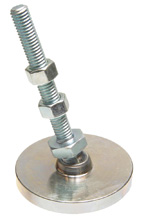
For uneven or wobbly equipment, look no further than leveling mounts. Also known as leveling pads or leveling feet, they offer a simple solution. You can install them on the bottom of the equipment. After adjusting the leveling mounts to the appropriate height, the equipment will become level. Leveling mounts are available in many different styles, however, one of which is low profile.
What Are Low-Profile Leveling Mounts
Low-profile leveling mounts are characterized by a low-profile design that sits close to the ground. They are still used to level machines, appliances and equipment. Low-profile leveling mounts simply have a low-profile design consisting of a thin base.
Like all leveling mounts, low-profile leveling mounts feature a base. The base is the bottommost part that touches the ground. Low-profile leveling mounts are distinguished from other types of leveling mounts by their short base. The base is thin and short, which allows low-profile leveling mounts to sit close to the ground.
Benefits of Low-Profile Leveling Mounts
Allowing uneven or wobbly equipment to go unchecked can result in damage — especially if it vibrates. Vibrations can cause the equipment to move. Over time, this movement can scratch the underlying floor or damage the equipment itself. Low-profile leveling mounts offer a solution. Once installed, you can adjust them so that the equipment is level with the floor.
While all types of leveling mounts support leveling, low-profile leveling mounts are ideal for small spaces. They provide stabilization to equipment without adding unnecessary height. For rooms and small spaces with low ceilings, you may want to go with low-profile leveling mounts for this reason.
Low-profile leveling mounts can also dampen vibrations and noise. Vibrations and noise, of course, go hand in hand. When equipment vibrates, it can make noise. Low-profile leveling mounts can absorb vibrations to promote a smoother and quieter equipment operation.
How to Choose Low-Profile Leveling Mounts
You should consider the material when choosing low-profile leveling mounts. Since they are installed on the bottom of equipment, they must be able to support heavy loads.
Steel is a popular material for low-profile leveling mounts due to its strength and durability. Steel mounts have a high load capacity, and they are resistant to corrosion. Some steel leveling mounts have a load capacity of 2,000 pounds, whereas others have a load capacity of up to 6,000 pounds.
Don’t forget to consider the thread size when choosing low-profile leveling mounts. If it’s too big or too small, you may struggle to install them. Low-profile leveling mounts feature a threaded stud connected to the base. You can mount them by twisting this stud into a threaded hole on the bottom of the equipment.
In addition to the thread size, check the stud length. The stud length represents the length or height of the threaded stud. It can range from 3 inches to 8 inches.
